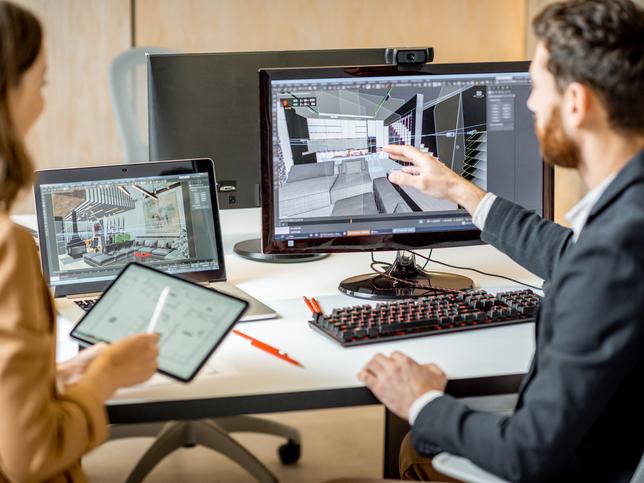Rapid technological shifts are transforming the workforce, making it increasingly difficult to predict the jobs of tomorrow. Universities face a critical challenge: how can we prepare students for careers that don’t yet exist?
Traditional degree programmes often focus on theory and foundational knowledge but they can fall short in equipping students with the adaptable, real-world skills needed for an unpredictable future. However, the UK’s degree apprenticeship model offers useful insights. By combining academic study with practical, work-based learning, it better prepares students with the flexible, human skills that are hardest to automate.
Drawing on my experience teaching degree apprenticeships, I offer practical strategies to help students develop the creative and social intelligence that will be essential in tomorrow’s workplace.
Start with the bottlenecks: what machines can’t do (yet)
Computers and automation still struggle with perception and manipulation, creative intelligence and social intelligence. These “bottlenecks” offer a roadmap for educators: by focusing on skills that are hard to automate, we can help students develop future-proof skills. In universities, this means helping students build skills through curiosity-driven learning and real-world problem-solving. It also means fostering social intelligence through realistic communication practice, structured “conflict” exercises and peer interaction. The following strategies aim to equip educators with classroom-tested tools to nurture these uniquely human capabilities.
Teach students to apply theory to real-life situations
Select a theory and craft a prompt that reveals how it connects to everyday experiences to help students see theory as a problem-solving tool. For example, in my innovation management class, I begin a session by asking: “What is one task in your work or personal life that frustrates you because it’s repetitive or inefficient?” Students then use an innovation process framework to develop solutions to their own problems. By focusing on real-life frustrations, students become more attuned to identifying underlying inefficiencies and unmet needs, which sharpens their ability to ask insightful questions. By the end of the course, my students reported an increase in curiosity about how theories could help them address everyday challenges.
- Spotlight guide: The evolution of authentic assessment in higher education
- How ‘interactive orals’ transform assessment – and how to implement them
- Three alternative assessments that build managerial skills
Bring in real voices
Invite industry speakers to help students link academic content to practice. To help students ask meaningful questions, I advise them to listen for two things during the talk:
- Practices the speaker describes that differ from the theory
- Examples that strongly align with the framework we’ve studied.
I then encourage students to ask why those differences exist or what challenges the speaker faced when applying the theory.
For example, a guest speaker shared a real-life example of managing change in a small company where the approach differed from Kotter’s classic change model. Students and the speaker then explored the specific constraints and challenges that small and medium-sized enterprises face when trying to follow the theoretical framework. This exercise helps students deepen their understanding and think critically about how theory translates into action.
Simulate real-life communication
Use role play to give students low-stakes opportunities to practise communication skills. In my negotiation classes, students pair up to role-play scenarios that incorporate common decision-making biases studied earlier in the course, such as anchoring, confirmation bias or loss aversion. I introduce these through readings and class discussions, and students must then use them as persuasion techniques during the exercise. I set a strict time limit for these exchanges and debrief right away. Afterwards, students reflect on what worked, what didn’t and how they could improve. Many report being more mindful of biases in real-life decision-making scenarios.
Don’t fear conflict – facilitate it
One effective way to develop critical thinking, persuasion and adaptability is to create opportunities for structured, supported disagreement. This means setting up a scenario with clearly defined roles, expectations and outcomes. This allows students “risk-free” opportunities to challenge each other’s ideas while learning how to respond constructively to opposing viewpoints.
For example, in a change management class, I divide the class into two groups. Members in one group act as project managers pitching a change initiative, and the others as executive board members challenging it. Students prepare in advance using course frameworks, then engage in a live exchange where they must defend their ideas and adapt in real time. I moderate to keep the discussion respectful, and debrief with the class after. Students have said the exercise helped them present under pressure and respond thoughtfully to pushback. Many reported feeling more confident handling difficult conversations involving tension or opposing views. This kind of structured disagreement helps normalise conflict as a valuable part of collaboration.
We can’t predict where students’ careers will take them in five or 10 years but we can help them develop the creative and social capabilities that machines still struggle to replicate.
Yuxi Heluo is lecturer in professional practice at the University of Exeter Business School, University of Exeter, UK.
If you would like advice and insight from academics and university staff delivered direct to your inbox each week, sign up for the Campus newsletter.




comment